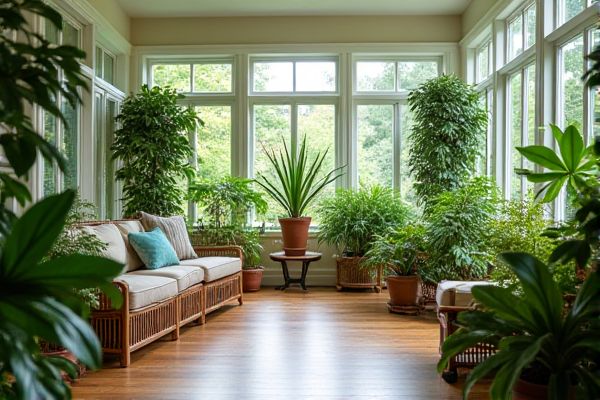
Sunroom plants provide natural air purification and enhance the aesthetic with thriving greenery that changes with the seasons, while artificial plants offer low-maintenance decor without the need for sunlight or watering. Discover the benefits and drawbacks of each option to determine which best fits Your sunroom's environment and lifestyle by reading the full article.
Table of Comparison
| Aspect | Sunroom Plants | Artificial Plants |
|---|---|---|
| Maintenance | Requires regular watering, pruning, and sunlight | Minimal upkeep, occasional dusting |
| Air Quality | Improves indoor air by producing oxygen and filtering toxins | No effect on air quality |
| Lifespan | Varies; can live years with proper care | Durable, lasts many years without degradation |
| Appearance | Natural, changes with seasons and growth | Consistent, unchanging look |
| Cost | Initial cost plus ongoing care expenses | Higher upfront cost, no ongoing costs |
| Environmental Impact | Eco-friendly, supports biodiversity | Made from synthetic materials, less eco-friendly |
| Placement Flexibility | Requires adequate sunlight, suitable climate | Can be placed anywhere, no light needed |
Introduction to Sunroom Décor: Live vs Artificial Plants
Sunroom decor thrives on the choice between live plants, which enhance air quality and bring natural vitality, and artificial plants, offering low-maintenance greenery with consistent aesthetics. Live plants like ferns, succulents, and orchids require proper sunlight and humidity levels found in sunrooms to flourish. Artificial plants provide allergy-free, year-round color and texture, making them ideal for busy homeowners or spaces with inconsistent light conditions.
Benefits of Real Plants in a Sunroom
Real plants in a sunroom enhance air quality by absorbing carbon dioxide and releasing oxygen, promoting a healthier indoor environment. Their natural growth supports humidity regulation, preventing dryness and improving comfort levels. Moreover, living plants contribute to mental well-being through their vibrant colors and natural aromas, creating a calming and aesthetically pleasing space.
Advantages of Artificial Plants for Sunroom Spaces
Artificial plants offer low-maintenance greenery ideal for sunroom spaces where natural light varies, eliminating concerns about watering or sunlight requirements. These plants retain vibrant color and shape year-round, enhancing your sunroom's aesthetic without seasonal changes or pest issues. You can easily customize arrangements to complement your decor while enjoying lasting beauty and durability.
Natural Air Purification: Real Plants Explained
Real sunroom plants enhance your indoor environment by naturally purifying the air through a process called phytoremediation, where they absorb toxins and release oxygen. Unlike artificial plants, live greenery can reduce indoor pollutants like formaldehyde and benzene, improving air quality and promoting better health. Your choice of natural plants not only brightens the space but actively contributes to creating a cleaner, fresher atmosphere.
Maintenance and Care: Real vs Artificial Approaches
Real sunroom plants require regular watering, pruning, and appropriate sunlight to thrive, making their maintenance dependent on consistent care routines and environmental conditions. Artificial plants eliminate the need for watering and sunlight, requiring only occasional dusting and cleaning to maintain their appearance. Choosing between real and artificial plants hinges on the desired balance between natural growth dynamics and low-maintenance decor in the sunroom environment.
Visual Appeal: Comparing Aesthetics
Sunroom plants offer natural beauty with vibrant colors and fresh greenery that change with the seasons, enhancing the overall ambiance of your space. Artificial plants provide consistent visual appeal without wilting or fading, maintaining a flawless look year-round with minimal upkeep. Your choice depends on whether you prioritize the dynamic charm of real plants or the effortless, permanent decor of artificial options.
Allergy Considerations: Pros and Cons
Sunroom plants improve indoor air quality by filtering pollutants and releasing oxygen, benefiting allergy sufferers with natural air purification and humidity control. However, live plants can trigger mold growth and pollen allergies, posing risks for sensitive individuals. Artificial plants eliminate pollen and mold issues but lack air-purifying properties and may accumulate dust, potentially aggravating respiratory allergies if not cleaned regularly.
Longevity and Durability: Which Lasts Longer?
Sunroom plants thrive in natural sunlight but require regular care to maintain their health and longevity, often lasting several years with proper attention. Artificial plants offer superior durability, remaining vibrant and intact for many years without maintenance, unaffected by sunlight or environmental factors. Choosing between them depends on whether longevity through natural growth or consistent appearance with minimal upkeep is prioritized.
Cost Analysis: Upfront and Long-Term Investment
Sunroom plants require an upfront investment in quality soil, pots, and regular maintenance such as watering and fertilization, leading to ongoing costs related to plant care and potential replacements. Artificial plants have a higher initial cost but demand minimal maintenance, making them more cost-effective over time, especially in low-light sunroom environments where real plants may struggle. Your choice influences long-term expenses depending on factors like durability, energy costs for grow lights, and frequency of plant replacement versus one-time artificial plant purchases.
Environmental Impact: Sustainability of Choices
Sunroom plants contribute positively to your home's environment by improving air quality and promoting natural humidity balance through photosynthesis. Artificial plants, while requiring no watering or sunlight, are often made from non-biodegradable plastics and can contribute to landfill waste, raising concerns about long-term sustainability. Choosing live plants over synthetic ones supports eco-friendly living with renewable resources and reduces your carbon footprint.
 homyna.com
homyna.com